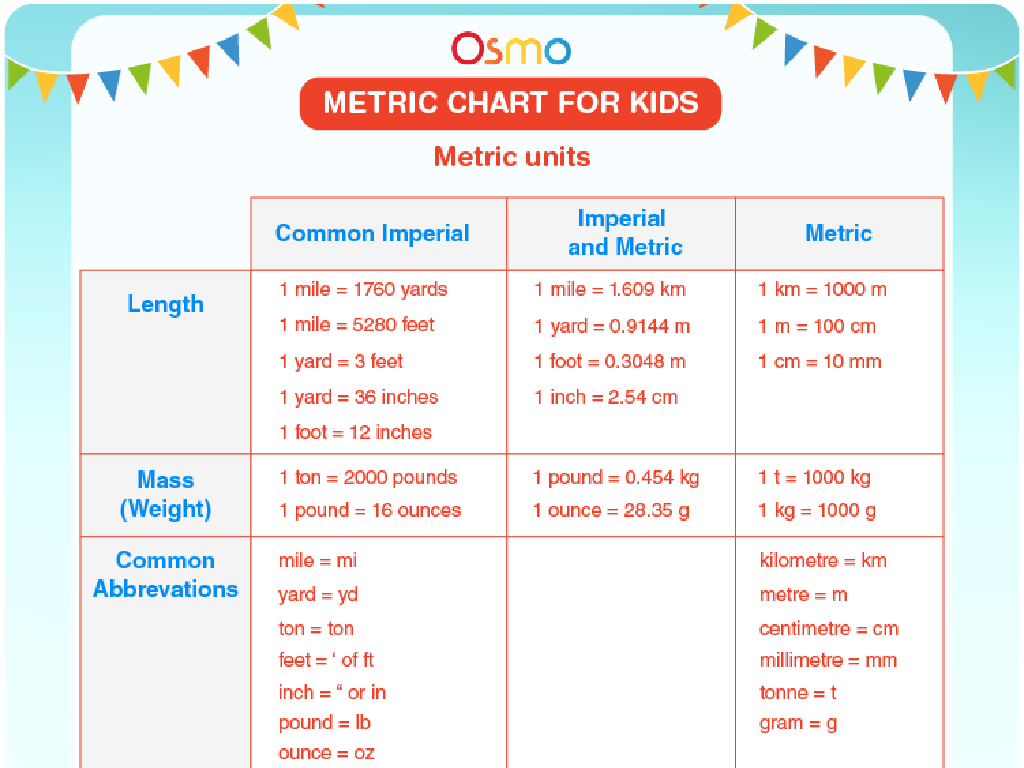Complete The Addition, Subtraction, Multiplication, Or Division Sentence
Subject: Math
Grade: Third grade
Topic: Mixed Operations
Please LOG IN to download the presentation. Access is available to registered users only.
View More Content
Welcome to Mixed Operations!
– Explore basic math operations
– Addition, subtraction, multiplication, and division
– Building blocks of mathematics
– These operations form the foundation for all math problems
– Completing mixed operation sentences
– Use clues to solve for the missing number in a math sentence
– Today’s learning goal
– Aim to confidently solve mixed operation problems
|
This slide introduces the concept of mixed operations to third-grade students, emphasizing the importance of understanding addition, subtraction, multiplication, and division as the core components of mathematics. The goal for today’s lesson is to enable students to complete sentences that involve a mix of these operations. As a teacher, you should demonstrate how each operation works with examples and then show how they can appear together in more complex problems. Encourage students to look for keywords and use the inverse operations to find missing numbers. Provide practice problems that require them to apply all four operations. By the end of the lesson, students should feel more comfortable with mixed operation sentences and understand how these fundamental skills apply to a wide range of mathematical concepts.
Addition Review: Combining Numbers
– Recap: Addition combines numbers
– When we add, we put together amounts to find the total.
– Example: 3 apples + 2 apples
– How many apples do we have in all?
– Solve addition sentences together
– We’ll practice with different numbers to see how addition works.
|
This slide is aimed at reviewing the concept of addition for third graders. Start by recapping that addition is the process of combining two or more numbers to find a total. Use relatable examples, such as combining apples, to illustrate the concept. Engage the class by solving addition sentences together, encouraging participation to ensure understanding. Provide a variety of addition problems and use visual aids like counters or drawings to help students visualize the process. Reinforce the idea that addition is about finding out how much we have in total when we put groups of things together.
Subtraction Review: Taking Away Numbers
– Recap: Subtraction means taking away
– Example: 5 stars – 2 stars
– If you have 5 stars and take away 2, how many are left?
– Solve subtraction sentences
– We’ll work through problems as a class
– Practice makes perfect!
– Keep practicing with different numbers
|
Begin with a quick review of what subtraction means, emphasizing the concept of ‘taking away’. Use visual aids like stars to illustrate the point. Present the example on the slide and solve it together, showing that 5 minus 2 leaves us with 3 stars. Encourage participation by having students come up to the board to solve similar problems. Provide a variety of subtraction sentences for them to practice with, and ensure they understand that consistent practice will help them become more confident in solving subtraction problems. Tailor the difficulty of the sentences to the class’s proficiency level.
Multiplication Review: Groups and Stars
– Multiplication as repeated addition
– Think of multiplication like adding the same number over and over!
– Example: 4 groups of 3 stars
– How many stars in total? 4 groups of 3 stars each equals 12 stars.
– Practice multiplication sentences
– We’ll write sentences like 3 x 4 = 12 to show multiplication.
|
Begin the lesson with a quick review of multiplication as a concept of repeated addition, which they have learned previously. Use visual aids like star groupings to help them understand. For example, draw 4 groups with 3 stars in each group and ask the students to count the total number of stars. This visual representation helps solidify the concept. Then, move on to writing multiplication sentences based on these groups, reinforcing the idea that multiplication is a faster way to add repeatedly. Encourage the students to create their own groups and write corresponding multiplication sentences. This activity will help them transition smoothly into more complex mixed operation problems.
Division Review: Sharing Equally
– Division creates equal parts
– Example: 10 cookies, 5 friends
– If we divide 10 cookies by 5 friends, each gets an equal share.
– How many cookies per friend?
– It’s like sharing! How can we split them fairly?
– Practice division sentences
– Let’s solve some together on the board.
|
Begin with a quick review of division as the process of splitting a number into equal parts. Use a relatable example, such as sharing cookies among friends, to illustrate the concept. This will help students visualize division as an act of fair sharing. Encourage students to think about how many cookies each friend would get if they were divided equally. After the example, engage the class with several division sentences, asking them to solve and explain their reasoning. Provide guidance and support as needed, and ensure that each student participates and practices the concept of division.
Mastering Mixed Operations
– Mixed operations in math problems
– Combining addition, subtraction, multiplication, or division
– Importance of order of operations
– Follow PEMDAS: Parentheses, Exponents, Multiplication/Division, Addition/Subtraction
– Examples of mixed operations
– 5 + 2 × 3 (Do we multiply first or add first?)
– Practice problems together
– Let’s solve step-by-step as a class
|
This slide introduces students to the concept of mixed operations, which involve using more than one arithmetic operation within a single math problem. Emphasize the importance of the order of operations, often remembered by the acronym PEMDAS, to solve these problems correctly. Provide clear examples on the board, showing step-by-step how to approach each part of the problem. Engage the class by working through practice problems together, asking students to participate in solving them on the board. This will help reinforce their understanding and give them the confidence to tackle mixed operation problems independently.
Solving Mixed Operation Sentences
– Identify each operation
– Look for plus, minus, times, divide signs
– Determine the solving order
– Remember: Multiplication and division before addition and subtraction
– Class example: 3 + 5 × 2
– First, multiply 5 × 2, then add 3
– Practice with different sentences
|
This slide introduces students to the concept of solving sentences with mixed operations. Start by explaining how to identify different operations such as addition, subtraction, multiplication, and division. Emphasize the importance of the order of operations, using the acronym PEMDAS as a guide, but focusing on the operations present in the examples for third graders. Work through the provided example as a class, demonstrating step-by-step how to solve it. Encourage students to participate in solving the example. Afterward, give students a chance to practice with different sentences, ensuring they apply the correct order of operations. This activity will help solidify their understanding of mixed operations.
Class Activity: Operation Stations
– Break into small groups
– Visit each operation station
– Solve mixed operation challenges
– Use addition, subtraction, multiplication, or division to fill in the blanks
– Collaborate and complete sentences
– Discuss with your group to find solutions
|
This class activity is designed to encourage teamwork and reinforce the concept of mixed operations. Divide the class into small groups and assign each group to a station with a unique operation challenge. Each station should have problems that require students to complete sentences using addition, subtraction, multiplication, or division. Encourage students to work together to solve the problems, ensuring that each member contributes to the discussion. As a teacher, circulate among the groups to offer guidance and ensure that students are on the right track. Possible activities include filling in missing numbers in equations, solving word problems, and correcting incorrect operation sentences. This hands-on approach helps solidify the students’ understanding of mixed operations in a fun and interactive way.
Great Work on Mixed Operations!
– Congratulations on today’s learning
– Homework: Mixed operations worksheet
– Practice addition, subtraction, multiplication, and division problems
– Check each step carefully
– Review your answers to avoid mistakes
– Bring any questions to class
– We’ll discuss any challenges you faced
|
This slide is meant to wrap up the day’s lesson on mixed operations and to set expectations for homework. The homework assignment reinforces today’s learning and provides additional practice to help students master the concepts of addition, subtraction, multiplication, and division. Remind students to take their time and check each step of their work to ensure accuracy. Encourage them to write down any questions or difficulties they encounter while completing the worksheet so that these can be addressed in the next class. This will help identify areas where students may need further explanation or practice.





